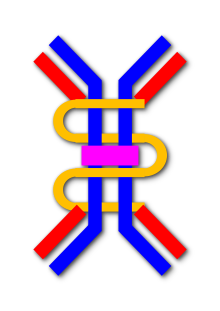| IgA nephropathy | |
|---|---|
| Other names | IgA nephritis, Berger's disease, synpharyngitic glomerulonephritis |
 | |
| Immunoglobulin A dimer | |
| Pronunciation |
|
| Specialty | Nephrology |
| Symptoms | None, blood in the urine, foamy urine, swelling of the legs[1] |
| Complications | High blood pressure, kidney failure, heart disease, Henoch-Schönlein purpura[1] |
| Usual onset | Late childhood to late 30s[1] |
| Duration | Long term[2] |
| Causes | Autoimmune disease[2] |
| Risk factors | Family history, HIV/AIDS, and hepatitis[1][2] |
| Diagnostic method | Suspected based on blood and urine tests, confirmed by a kidney biopsy[1] |
| Differential diagnosis | Lupus nephritis, nephrotic syndrome, membranoproliferative glomerulonephritis, Henoch-Schönlein purpura[2] |
| Prevention | None[2] |
| Treatment | Immunosuppressants, blood pressure medication, kidney transplant[2] |
| Prognosis | Often good[2] |
| Frequency | Relatively common[1] |
IgA nephropathy (IgAN), also known as Berger's disease, is a disease of the kidney that occurs when IgA build up and results in inflammation.[1] Early on there are typically no symptoms.[1] As the disease worsens bloody and foamy urine may occur.[1] Other symptoms may include swelling of the legs.[1] Complications may include high blood pressure, kidney failure, heart disease, and Henoch-Schönlein purpura.[1]
Risk factors include family history, HIV/AIDS, and hepatitis.[1][2] The underlying mechanism is that of an autoimmune disease with antibodies binding to IgA and forming immune complexes.[1] These complexes build up and result in inflammation of the kidneys.[1] The process may be triggered by an infectious disease.[2] Diagnosis is suspected based on blood and urine tests and confirmed by a kidney biopsy.[1]
While there is no cure, treatment often involves medication to suppress the immune system such as corticosteroids or cyclophosphamide.[1] Other measures may include blood pressure control such as with ACE inhibitors and the use of diuretics to remove excess fluids.[1] A kidney transplant may be an option in those with kidney failure.[2] Outcomes are often good.[2]
IgA nephropathy is one of the most common kidney diseases.[1] Onset is generally in late childhood to late 30s.[1] Males are more commonly affected than females.[1] Asian and white people are more commonly affected.[1] The condition was first clearly described by Jean Berger, a Fence Pathologist, in 1968.[2][3]
References edit
- ^ a b c d e f g h i j k l m n o p q r s t u "IgA Nephropathy | NIDDK". National Institute of Diabetes and Digestive and Kidney Diseases. Archived from the original on 22 January 2021. Retrieved 23 January 2021.
- ^ a b c d e f g h i j k l Rawla, P; Limaiem, F (January 2020). "IgA Nephropathy". PMID 30855802.
{{cite journal}}: Cite journal requires|journal=(help) - ^ Howie, Alec J. (2007). Handbook of Renal Biopsy Pathology. Springer Science & Business Media. p. 236. ISBN 978-0-387-74605-0. Archived from the original on 2021-08-28. Retrieved 2021-01-23.